By Angie Vincent
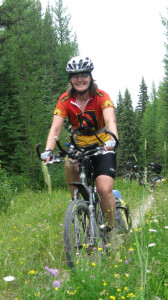
The Great Divide Mountain Bike Route is definitely an adventure to add to your bucket list. My husband, Vince, and I started bike touring about 6 years ago with our first major ride beginning at our house here in Salt Lake City and ending up in Savannah, Georgia. After that we were hooked on touring. Vince kept bringing up the fact that he wanted to ride the Divide. The Great Divide Mountain Bike Route is a continuous long distance bicycle touring route from Banff, Alberta, Canada to Antelope Wells, New Mexico, USA (at the Mexico border). The route is approximately 2,700 miles long and follows the Continental Divide as closely as practicable, crossing it 30 times. About 90% of the Divide is on unpaved roads and trails and requires basic off-pavement riding skills to complete. Also, keep in mind that the route has over 200,000 feet of elevation gain—the equivalent of summiting Mount Everest from sea-level 7 times.
The “basic off-pavement riding skills” and the sheer magnitude of all that climbing had me quaking in my cleats. I never considered actually riding the Divide because I thought it was way beyond my capabilities; but, I was more than willing to watch a film about it. Vince and I saw an awesome documentary called “Ride the Divide” and that changed my mind. The Divide didn’t look so bad. I was just thinking out loud when I told Vince that, “I think I can do that.” That’s all it took for him to start making plans. And once you tell all your friends, you’re committed!
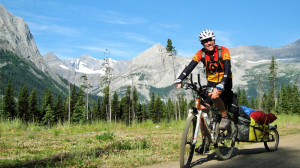
The Divide is within most people’s ability and thousands of people have ridden all or parts of the trail. Just a little bit of training and anyone should be able to ride the Divide. I myself am just a normal person without any super powers or extreme physical attributes. Almost everybody passes me when I’m mountain biking. I’m also not young any more, at the time I was 48 and Vince was 55 years old. Whatever your skill level or ability, just organize the ride according to your own individual ability. You can do as many or as few miles each day as you feel like. You can also break the trail up into sections and do a section at a time. By comparison, there is a Great Divide race (The Tour Divide) each year with the record being 15 days, 16 hours and 14 minutes to complete the entire route. We did the Divide in 2 trips taking about 6 weeks each. In Aug 2011 we biked from Banff to Rawlins, WY which took about 5 weeks. When temps fell to below freezing at night, we decided we’d had enough and biked home on I-80 from Rawlins (which added another 300 miles to that ride). The following summer (Aug 2012), a friend dropped us off in Rawlins and we headed south to complete the Divide. As you can see, the trip can be as fast or as slow as you want depending on your stamina, time, and desires.
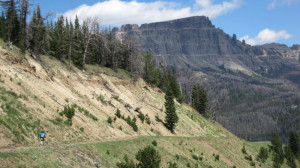
The appeal of this ride is that you’re off the beaten path and spend many, many miles in the back country. It is highlighted by long dirt roads and jeep trails that wend their way through forgotten passes. There are also numerous hardships that must be dealt with: you’ll be travelling in bear country, long distances between services of any kind, navigational issues (it’s not a matter of if you get lost, but when you get lost), lengthy grinds to summit passes, and fast changing weather patterns that can make your day miserable in a matter of minutes. Added to that is that you spend a lot of “alone” time with your biking partner which brought out my inner angry self…I once got so mad at Vince I threw my bike at him…he still loves to tell that story to anyone who’ll listen. I’m sure it was all his fault.
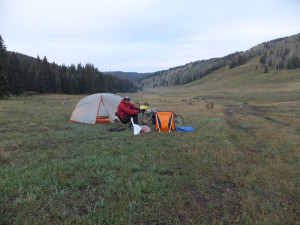
Vince enjoyed this trip more than any other one because he got to “stealth” camp which means finding a place away from everyone. And since we were so far away from civilization, we did do a lot of it. This meant using good bear procedures and making sure you left no trace and sometimes hiding behind bushes. We would usually wait until the end of day and try to find water right before looking for a place to camp. This would preclude us from having to schlep water for any great distances. I prefer camping in a commercial campground because you have more amenities but camping in the wild does have its charm. First off, it’s usually more quiet and peaceful than a campground and there are no barking dogs, slamming car doors or noisy generators. Secondly, it’s usually free! Often times we were traveling through Forest Service or Bureau of Land Management areas where camping is allowed. Other times we just looked for a wooded area away from houses and set up camp. Of course, if we were near a large town, I would pamper myself with an occasional night in a hotel with shower, bed, TV, fridge and air conditioning.
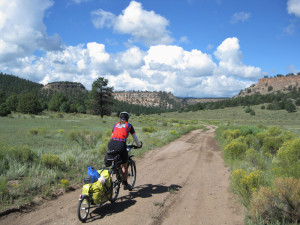
Sometimes a girl just needs a shower. Guys, on the other hand can go for days between showers. The thing about showers is that, if you want a warm one, you have to do it in the middle of the day because you need about two hours of sun to warm up a water bladder. Waiting until evening would not allow the sun enough time to heat water and the air temperature would be cooler too. A trick we found was to find a gas station or restaurant, fill up a bladder with hot water and find a bush to jump behind for a nice hot shower — quick and easy. If you’re really determined to get clean, just dive into the nearest lake or stream but that is usually too cold for me. And if all else fails, pull out the wet wipes.
Even with the adversities, you get a deep appreciation of the land you ride through. The route had such a diverse range of scenery, from the lush green mountains of Canada and Montana to the arid and open ranges of the Great Basin, to the rugged high desert of New Mexico. Most days, Vince and I would wake up to 30 degree mornings and by mid-afternoon, the temps would reach 90 and above. On one particular day, we summited a pass in New Mexico where I stopped to talk to a sheep herder. He spoke no English and I spoke no Spanish, but we managed a conversation that I think included him saying how crazy I was. On the downhill side of that pass, it started raining on us and the temps dropped to the 30’s. I had to stop to put on every piece of clothing I owned (shivering at this point). Then the sun came out, and I immediately had to start stripping because the temps escalated. Even with the sun shining we bogged down in mud and spent 2 hours digging *&^%)%$ mud out of our bikes.
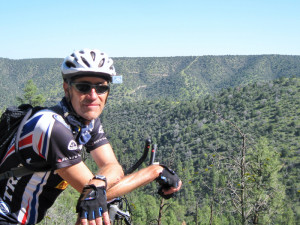
Vince and I rode our full suspension mountain bikes and pulled BOB trailers but we also saw several people riding regular touring bikes with panniers. We like to travel in comfort so we tend to be loaded on the heavier side. The equipment we packed ensured we were ready for just about anything and included tubes, an extra tire, chairs, cooking gear, tools, water filters, and on and on. Check out the web for more detailed lists. Basically, anything you need for a short 3-day training ride will get you through any longer ride. Just pick up enough food to get you between towns and carry enough water to get you to the next water source. The maps recommend a north to south direction and beginning no earlier than late June. Regardless of when you strike out or how long you intend to be out, snow or cold rain is possible any day of the year at some of the elevations encountered.
We did have our share of break downs which included broken spokes and tire problems. I crashed because a front tire blew out on a gravel decent. At that point all our tires were shot so we called REI and had them ship tires ahead to a hotel down the trail (REI and FEDEX rock!). If you really get into trouble you can always flag down another biker, dirt bike or car and get help. There wasn’t a day that we didn’t see at least one other person.
Another memorable aspect of riding the Divide are the assortment of people undergoing the ride like you; some riding a section or two, some riding the entire route, some single riders, others in groups. Christian, from Holland, rode with us, off and on, for about a week after meeting up with him in Montana. He left us when he decided to make a side trip. We happened to be at a bike shop (the owner was kind enough to let us check our email on his computer) in Island Park, Idaho, when Christian wandered in. He was desperate for a new tire because his was beyond repair. He had hitched a ride into town and, unfortunately, this bike shop didn’t have a tire to fit his bike. Since we had a spare tire, we sold it to Christian and had a new one sent ahead to replace it (again REI and FEDEX rock). We saved the day for Christian and got a few karma credits for ourselves.
We also met some interesting local characters along the way. Vince and I usually rode at different speeds with Vince being much faster than me. He would ride ahead and when the route made a turn, he would pull out his handy chair, dig out the book he was reading, and wait for me. One day, a man drove by, saw Vince sitting by the road and offered him some water at his home which we would be passing by in a few miles. Arriving at his home, all the family came out to gawk at our bikes. The homeowner gave us fresh water (from his well) and then proceeded to give us a pound of frozen hamburger meat (obtained from his own herd of cattle), and then produced a bag of fresh raspberries picked from his yard…we ate in style that night.
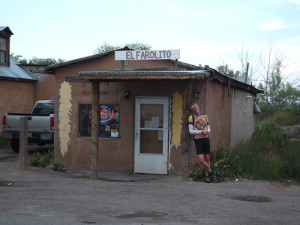
Food is always on the brain when doing an adventure such as this one. We had met up with a fellow cyclist who lived in Del Norte, Colorado, to pick his brain on the upcoming section of the route. He told us about a fantastic Mexican restaurant in El Rito, New Mexico, a small town we would be passing through. El Rito, population 800, was on the edge of a national park and since we had just finished that section, we were getting low on our supplies. The town itself consisted of one main street, a few scattered homes, boarded up buildings, and really just a crossroad for folks on their way somewhere else. If we hadn’t been told of the restaurant, we would have just passed it by. If fact, we did pass it and found a convenience store on the other side of the town. The store clerk gave us the address for the restaurant, and we headed back the way we had come. The restaurant was so small, actually no bigger than most people’s garage, and was late opening up. The cook finally showed up and let us in but we had to wait for their ovens to heat up. But it was so worth the wait. It was, by far, the best meal I had on the entire trip.
When you ride 5 to 8 hours a day you can eat almost anything without gaining weight. There are lots of options for food and sometimes it is overwhelming to walk through a grocery store trying to decide what you want to eat for the next couple of days. Because we’d rather ride than cook, we liked to eat at a restaurant if we happened by one. Moreover, it’s hard to pass up chocolate milk or ice cream novelties which are available in most convenience stores and gas stations. When cooking, we used a Jetboil stove with a cooking pot. Easy to cook are frozen skillet meals from the grocery store. Just pick your favorite and let it thaw for a couple of hours on top of your panniers and, presto, it cooks up in minutes for a quick, delicious meal. Ramen noodles, also a favorite, cook up in five minutes and you can always throw in a package of chicken or beef for a no-fuss meal.
All in all, this trip by far was been one of the hardest things I have attempted. It is a test of endurance and willpower; some of the climbs were never-ending, windy days with non-stop headwinds, going from super cold to super hot, dealing with bugs and other critters, and just being miserable at times. But then, you’d top out on a mountain pass and the view would be so breathtaking your soul would tingle! It was a struggle for me but I’m glad I did it and now have bragging rights…I’d do it again.
Maps for the entire trip can be obtained through Adventure Cycling Association (ACA). ACA also has an official guidebook by Micheal McCoy, Cycling the Great Divide, which gives a detailed account of the entire route…and I might add, Vince and I have our picture in the book! There are tons of equipment lists on the web as well as maps and blogs that would be helpful if you decide to go.
It is by riding a bicycle that you learn the contours of a country best, since you have to sweat up the hills and coast down them. –Ernest Hemingway
Tips for the Trip
When to go
Recommended best time is to begin riding at the Canadian border in early July; arrive in the high country of Colorado in August, when the route there is snow-free; and finish up in the potentially hot and dry New Mexico portions in late September/early October, when things have cooled down a bit.
Maps and Routes
Maps for the entire route can be obtained through Adventure Cycling Association. Also available is the official guidebook, Cycling the Great Divide, by Michael McCoy. Also recommend getting local maps. Since many of the roads you’ll be travelling on are logging roads, they can and will change, so the possibility of getting lost is high.
Road Conditions
Mostly dirt and gravel roads (86%) with some paved roads (12%) and a few single-track trails (2%). You will experience a lot of washboard surfaces on the dirt roads.
Bike and Equipment
A sturdy bike is a must. We had mountain bikes with front and rear suspension and pulled BOB trailers. However, we saw all types of set ups on the trail, from regular touring bikes to tandems, to hard-tail mountain bikes. Be prepared for bike emergencies as bike shops are few and far between.
Ease of Getting Food/Water
There are several sections on the route that have little to no services of any kind. Don’t count on being able to find something that’s open. We had several instances where a store was closed the day we went through or had gone out of business. There are also a couple of sections where water is an issue (going across the Great Basin and sections in New Mexico). These sections are clearly marked on the maps.
Transportation
To get to the start of the route, we had a friend drive us to Banff, Alberta, Canada. If flying, the nearest airport is Calgary. We ended our trip in Silver City, New Mexico. A local bike shop, the Gila Hike and Bike Shop boxed and shipped our bikes home and we took a bus to El Paso, Texas and flew home to Salt Lake City.












Excellent story Angie. We always get inspired by your adventures Thanks for sharing!
Comments are closed.